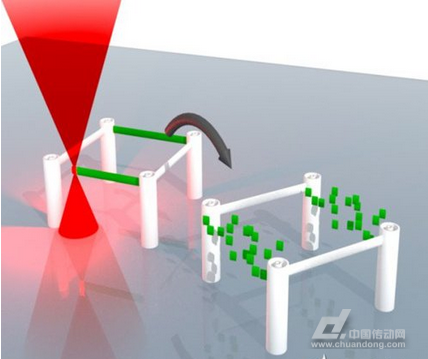The importance of 3D printing as a part of industrial production methods is growing, mainly due to the gradual maturation of additive manufacturing technologies. A research project at the Karlsruhe Institute of Technology (KIT) in Germany has the potential to make significant progress in the area of ​​3D printing, enabling the production of industrial products, erasing and modifying certain structures on demand. The study has been published in the German Journal of Applied Chemistry. The research breakthrough of Karlsruhe Institute of Technology involves a new formula for inks that are used in the direct laser writing (DLW) manufacturing process - the inks are coupled under the action of a laser to generate a pre-programmed The sturdy structure of the design. Christopher Barner-Kowollik of the Institute of Chemical Technology and Polymer Chemistry at the Karlsruhe Institute of Technology commented: “The development of re-eraseable inks is one of the major challenges of direct laser writing technology.†The research project developed an ink with reversible coupling properties to meet this challenge, and this ink can decompose the entire structure after completing the construction process of the product structure. Repeated Write and Erase: 3D Microstructure The chemical structure of the ink is first formed by the DLW radiation of a phenacyl sulfide linker, which in turn generates reactive disulfide bonds during the stepwise polymerization of reactive ethanethiol. Subsequent immersion of the material in dithiothreitol causes breakage of the chemical bonds until complete digestion, after which direct laser writing can be used again to create new or modified structures. In this way, the final structure of the project can be repetitively changed as the designer modifies the drawings. Three-dimensional microscopy According to published papers, the breaking of chemical bonds can be used as a structural design tool because the cleavage of chemical bonds in dithiothreitol tends to be highly orthogonal to the chemical bonds generated by DLW in other acrylate-based structures. Under normal conditions, this selective fracture allows the research team to use a new material to produce an excellent grating with a line resolution of 300 nm. New inks are currently available for a variety of DLW applications, such as integrating the structure of erasable and non-erasable regions, as well as constructing structures for the production process and erasing them after use. Another use is for 3D design petri dishes in biology. This is a topic that Karlsruhe Institute of Technology has studied. Its researchers completed the research on the three-dimensional growth of cell culture in laboratory scale in 2016. In September of last year, she won the Schrödinger Prize. In combination with the new erasable technology, researchers were able to remove portions of the three-dimensional cell scaffold during cell growth to study how cells respond to changing conditions. Other studies on 3D printing at the Karlsruhe Institute of Technology include process development using optical glass for additive manufacturing technology, which has opened up many potential applications in the field of optics, which are currently limited to metal or polymer materials. Windshield Cell Phone Mount,Car Windscreen Mobile Phone Holder,Car Windshield Cell Phone Holder,Car Windscreen Cell Phone Holder Ningbo Luke Automotive Supplies Ltd. , https://www.nbluke.com
How 3D Printing Accelerates the Times of Intelligent Industry
A research project at the Karlsruhe Institute of Technology (KIT) in Germany has the potential to make significant progress in the area of ​​3D printing, enabling the production of industrial products, erasing and modifying certain structures on demand.